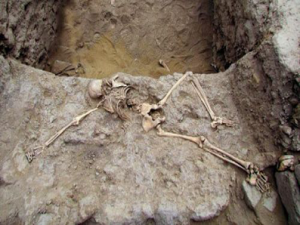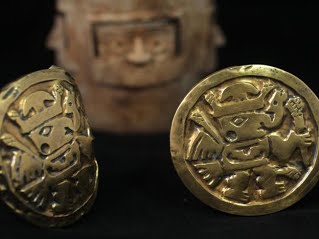

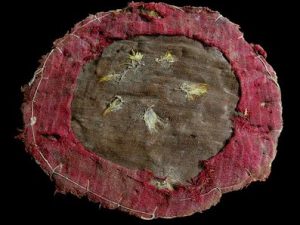 Number 512 November 2013 Edited by Micky Watkins
Number 512 November 2013 Edited by Micky Watkins
HADAS DIARY 2013 & 2014
All Lectures are held at Avenue House, 17 East End Road, Finchley, N3 3QE, and start promptly at 8.00 pm, with coffee/tea and biscuits afterwards. Non-members welcome (£1.00). Buses 82, 125, 143, 326 & 460 pass nearby and Finchley Central Station (Northern line) is a short walk away.
Tuesday 12th November, 8pm The Lions on Kunulua: excavations of the Early Bronze and Iron Age periods at Tell Ta’yinat, Hatay, Turkey -this is an occupation mound site near the ancient city of Antioch (Antakya) adjacent to the Syrian border. Since the late 1990s, Prof Tim Harrison of the University of Toronto has led survey and excavation work on the mound and the surrounding area of the lower tell with some spectacular results especially over the past few years – large statuary with many intact, a temple site, cuneiform tablet fragments and an almost-complete extremely rare treaty document, and many fragments of Luwian script. A metal working site and lots of artefacts of the textile production that took place on this site have also been uncovered along with evidence of trade with groups on the Indian Ocean, the Black Sea and the Mediterranean; all have shown the importance of Tell Ta’yinat. The site was formerly known at Kunalua during the Neo-Hittite/Aramean periods and is referred to as Calneh in the Old Testament. Lecture by Dr. Fiona Houghey who has worked with Tim Harrison for 10 years on this site.
Sunday 1st December, 12 noon – 4.30 pm (approx.) HADAS Christmas Party at Avenue House.
Buffet lunch. Price £25 to include one drink. Cash bar.
Tuesday 14th January 2014, 8pm The Naval Graveyards of Greenwich. Lecture by Malcolm Godfrey
Tuesday 11th February 2014 To be announced.
Tuesday 11th March 2014, 8pm The Sandridge Coin Hoard. Lecture by David Thorold, Curator (Prehistory to Medieval), Verulamium Museum.
Tuesday 8th April 2014, 8pm Restoring House Mill (working title) Brian James-Strong, River Lea Tidal Mill Trust.
Reminder of London & Middlesex Archaeological Society (LAMAS) Local History Conference
These details were also in the last Newsletter, but here’s a reminder for what promises to be a very interesting occasion: LAMAS’s 48th Local History Conference at the Weston Theatre, Museum of London on Saturday, 16th November 2013 from 10.00am to 4.00 pm. This all-day conference on the subject of “The River and Port of London” will have, as usual, displays by local history societies throughout the day.
Tickets are available now. The cost is £12 per person if paid before the 31st October, or £15 per person from 1st November. Ticket applications to: Eleanor Stanier, LAMAS Local History Conference, 48 Coval Road, East Sheen, London SW14 7RL enclosing a cheque payable to LAMAS and a stamped addressed envelope for the tickets, or via the LAMAS website (www.lamas.org.uk/localhistory) using Paypal.
Brigitte Hay Jim Nelhams
Back in July, we noticed a brief notice in our local newspaper (Barnet Times) recording the death of Brigitte Hay, a name which rang a bell. The cremation date, which was some while later, was noted. We remembered Brigitte coming on some of the HADAS outings, often with Renate Koenigsberger. Brigitte had bad eyesight and used what looked like a small telescope to read. I recall them both on our long visit to Plymouth. Both ladies had allowed their membership to lapse.
Jo and I attended the cremation service on behalf of HADAS, and there, we learned that Renate had died in 2012. A number of Renate’s family were also at the service, and a cousin, Sophia Kingshill, has kindly provided the following information. A fuller obituary written by another cousin, Gustav Born, appeared in The Guardian on 17th June 2012 (and available on the internet), noting that Max Born, Renate’s uncle was a Nobel Prize winner, and also that Max was also the grandfather of the singer, song-writer and actress Olivia Newton-John. Further information about Brigitte will follow.
Renate Koenigsberger Sophia Kingshill
Renate was born in 1919, the only child of a talented artist, Wolfgang Born, who was half-brother of the famous physicist Max Born. She lived in the German town of Breslau (now Wroclaw, Poland) until the 1930s, when she and her mother moved to Britain to escape the Nazi regime.
She studied chemistry, gained her PhD, and became a lecturer at Surrey University. In 1957 she married her cousin Otto Koenigsberger, with whom she had had a friendship going back to childhood. Otto was an architect with an international reputation, and he and Renate travelled extensively in Asia and Africa. They were well informed about history and archaeology, and collected fascinating artefacts in their travels, including a stone Buddha, rescued from a demolished shrine in India, that was displayed on the wall of their Hampstead home.
After Otto’s death in 1993, Renate continued to be the centre of a wide circle of friends and family from all over the world. Her house was full of pictures and books on almost every subject, and she was always interested in and knowledgeable about politics, history, art, architecture and archaeology.
Renate and Otto had been friendly for some time with Brigitte and Michael Hay, and after Michael’s death, Renate and Brigitte became close companions who shared cultural interests and went on holiday together. The friendship meant a lot to both of them.
South American road trip – a post script Tim Wilkins
The archaeological activity in Northern Peru is so vibrant that there are stunning new finds happening all the time. Archaeologists are even flying drones in order to survey their sites, find new sites, and keep a watch out for looters. Here are a few of the discoveries just since we were there in the summer.
El Brujo (see HADAS newsletter no. 510, September 2013)
Continuing excavations at the site of three Moche pyramids have found the remains of a young woman. Unusually she was buried alone – the other burials at the site have been of royal women with servants and guards – with no grave goods, and buried face down pointing out to the ocean. Aged between 17 and 19, she shows no signs of strangulation or other injuries.
Panamarca, Ancash province. In July in the Ancash region of North West Peru, an excavation at another Moche site has found a shield of woven basketry with a handle and covered with feathers, originally about a hundred, of which only a dozen survive. Moche shields are generally quite small; this one being some 10 inches in diameter. The Moche lived in the coastal desert area, but the feathers are Thought to be from Macaws, so must have been imported over the Andes from the Amazonas region.
An unlooted Wari tomb.
Also in the Ancash region, and briefly touched on in the September newsletter, an untouched Wari (also spelled Huari) tomb was found earlier this year and more details are now being released. The Wari culture dates from around 1000 AD up to the arrival of the Inca, and they were probably a rival to the Moche (see above). This coastal site at El Castillo de Huarmey (“The Castle of Death”) has produced over 1000 artefacts including gold and silver jewellery, bronze axes, and gold weaving tools, as well as three Wari queens and 60 other individuals. Like the Moche when they buried a queen, they seem to have buried her with a number of female servants, and, at a slightly different level in the chambers, male guards. The team estimate that they have at least another 8 to 10 years work at the site.
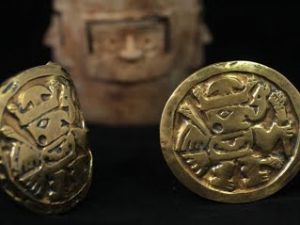 Chavin de Huantar (Also see HADAS newsletter no. 510 September 2013)
Chavin de Huantar (Also see HADAS newsletter no. 510 September 2013)
Two more carved heads have been found at the site, to go with the 100 already discovered. These are thought to have been part of a row along the top of a wall that fell down and were buried during an earthquake. Like the ones pictured in the September article, these seem to show a human head, maybe that of a priest, as it is transformed under the influenced of powerful hallucinogenic hypnotics such as that from the San Pedro cactus. These were used in rituals to help the priest pass from the human world into the spirit world, during which their heads would take on features of animals and birds. The two new heads have bulging staring eyes and flared nostrils, also a sign of San Pedro use, and are covered with wrinkles and a dozen snakes.
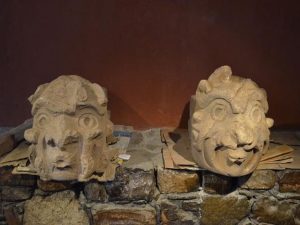 And finally . . . The Atacama Desert in Northern Chile is known as the driest place on Earth, with no rainfall at all for decades on end, and with zero atmospheric moisture, which is why so many astronomical observatories are situated there. The picture below was sent to me a couple of weeks ago from a contact of mine – the Atacama under snow!
And finally . . . The Atacama Desert in Northern Chile is known as the driest place on Earth, with no rainfall at all for decades on end, and with zero atmospheric moisture, which is why so many astronomical observatories are situated there. The picture below was sent to me a couple of weeks ago from a contact of mine – the Atacama under snow!
Buxton Trip – Day 1 Jim Nelhams
Off we go on the 2013 HADAS long outing. This year, 40 people joined the coach, with driver Garry, for our trip to Buxton and the Peak District. All aboard, we headed north with a brief comfort stop en route to Piddington and Papplewick. One of our objectives for these trips is to find places that members don’t know, or would not visit on their own. HADAS has been to Piddington before, but Papplewick has not featured in previous outings.
Piddington Roman Villa Don Cooper
For our first stop we arrived at Piddington, a little village six miles South-East of Northampton. Here we were met by Roy Friendship-Taylor, his wife Liz and members of the Upper Nene Archaeological Society (UNAS). We divided into two groups, with one group walking the half mile or so to the site where Roy explained the history of the site and the interpretation of the current (2013) excavation, the other group went to the museum. The museum is full of artefacts found on the site and the volunteers from UNAS provided us with tea and coffee, biscuits and beautiful lemon drizzle cake!
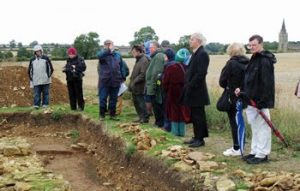 Roy and his team have been excavating the known Roman Villa site since 1979. As a result, the Piddington excavation has provided a comprehensive view of the development of the villa from an early Iron Age settlement, through the early Roman military period and on through the various stages of the villa’s development. HADAS Vice President Andrew Selkirk in his article on Piddington referred to the excavation as one of the best explored Roman villas in the country (Selkirk (ed.) 1996. Current Archaeology Vol. X111 page 2). Roy’s great enthusiasm for what is a life’s work is infectious and despite it being chilly, we all hung on to his every word as he guided us round the excavation (see photo)
Roy and his team have been excavating the known Roman Villa site since 1979. As a result, the Piddington excavation has provided a comprehensive view of the development of the villa from an early Iron Age settlement, through the early Roman military period and on through the various stages of the villa’s development. HADAS Vice President Andrew Selkirk in his article on Piddington referred to the excavation as one of the best explored Roman villas in the country (Selkirk (ed.) 1996. Current Archaeology Vol. X111 page 2). Roy’s great enthusiasm for what is a life’s work is infectious and despite it being chilly, we all hung on to his every word as he guided us round the excavation (see photo)
The Piddington Roman villa is a great example of an archaeological research project being carried out by an amateur archaeology group (UNAS) and led by a very knowledgeable and charismatic leader. The museum of the excavation is housed in a disused Wesleyan chapel. It contains thousands of the artefacts found on the site with many of the most interesting ones on display. Once the group visiting the site returned to the museum we “changed ends” so to speak.
There is also an interesting-looking Victorian Church in the village but being Sunday morning there was a service taking place so few of us got a chance to visit it. The site deserves a full day’s visit as we only scratched the surface – perhaps a HADAS trip next year?
Papplewick Pumping Station Jo Nelhams
This is yet another situation when a piece of History is being maintained and preserved for future generations by enthusiastic volunteers. Papplewick Pumping Station was constructed to increase the water supply to Nottingham, which is eleven miles away, as the city expanded during Victorian times. It is an example of the splendid engineering projects which continued the expansion of the Industrial Revolution. It is one of Britain’s finest Water Works and the only one in the Midlands to be preserved as a complete working fresh water pumping station. It was built between 1882 and 1884 and the two massive beam engines are thought to be the last built by the famous firm of James Watt & Co. of Soho Works, Birmingham and London. It is now a Grade 2 star listed building. There are two main rooms, the boiler room and the machine room. The boiler room houses six large Lancashire boilers. Three boilers were needed to be fired in order to feed steam to the beam engines.
As you enter the machine room you are greeted by an elaborately decorated room. The stained glass windows all have water related designs and the pillars supporting the upper floors have magnificent gold coloured bird figures resembling ibises at ceiling level. The building was completed eight hundred pounds under budget, so this spare money was spent on decoration. As the pumps are an integral part of the building, a vertical spirit level is checked regularly to make sure there has been no movement to upset the balance of the machinery. On display were some huge spanners which needed tremendous physical strength to even lift, let alone use. The beam engines worked for 85 years and ceased regular operation in 1969. Papplewick’s upkeep is now in the hands of an enthusiastic bunch of volunteers. It was opened to the public in 1975 and some of the volunteers are the original founders of the preservation group to supplement the income, the pond outside is now used by a local fish farm for breeding carp. Another novel way for raising funds is that the building is licensed for weddings. There was still some evidence of a wedding that had taken place on the previous day.
The pumps were not in steam on our visit, but some members expressed the desire to return to witness the pumps in operation.
Up to the Heights and Down to the Depths Deidre Barrie
Our coach sped to Matlock Bath in better weather, to visit the Heights of Abraham. In 1724 Daniel Defoe wrote that Matlock Bath had “a base, stony, mountainous road to it, and no good accommodation when you are there.” Luckily times have changed.
Britain’s first alpine cable car system was opened to the public in 1984. Cable cars each carrying six passengers took us high above the River Severn up to Masson Hill. The Hill (1,111 ft above sea level) was renamed the Heights of Abraham after its supposed similarity to the site of General James Wolf’s victory in Canada (where the 1759 battle site is known as the Plains of Abraham).
For those in our party who did not fancy the cable car ride or the visit to the Great Masson Cavern, there was an exhibition centre with films of these perils to watch in comfort as well as “The Fossil Factory”, a shop, and a terrace café with spectacular views.
The Great Masson Cavern was formerly a lead mine, and opened to the public in 1844 when the deposits of lead declined. Lead has been mined here for centuries – a pig block of lead exists with a Roman inscription on it. This was an adventure – we wore hard hats and had to stoop almost double to trudge along low tunnels with wet floors. A state of the art lighting system in the huge main cavern went from complete darkness, to demonstrating the tiny lights the miners would have used, then to a pretty coloured light show. Names and dates from the 18th Century were visible on the rugged sides of the mine where the owners of seams had wanted to stake their ownership. Back to Buxton with time for a quick look at the local museum.
The Peak Mining Museum at Matlock Bath. Simon Williams
The Museum is housed in the Pavilion building of the former pump-room from when it was a Spa, alongside the Derwent River. The mining history begins with the Romans, some 2,000 years ago. Galena (lead ore) was what was extracted.
On entering one is impressed by short simulated hewn rock galleries, with trucks, which can be passed along. There are a few working models for ‘button-pushers’, there are good displays, and the museum displays a fine array of tools. Ancient Laws controlled the miners. It was a thrill to see a Trevithick (1771-1833) pumping engine here. Trevithick was also the first builder of a full-scale working steam railway loco in 1804. It is an interesting paradox to move water, in the form of steam, to remove water! The Museum also had a good display of the tools and materials involved in the dynamiting process to access new seams. At the end there was a fine display of minerals clearly shown. A good Museum.
Barnet Then & Now – Published 1/11/2013 Don Cooper
96 pages, ISBN-13: 978-0752488325, pub. The History Press, £14.99
Yasmine Webb, the former collections manager of Barnet Local Studies, has created a very attractive book, rich with images, of Barnet past and present.
Many of the images that have been captured show familiar sites of today that can be compared with their predecessors, effectively illustrating how Barnet, despite undergoing many changes, has still managed to retain its historic identity. The charming geographical layout of the highest hills and adjoining valleys of north London create fantastic views that have been well documented by numerous artists and writers.
Choosing the images that give the architecture its merit was both a challenge and a labour of love due to the size and topography of the borough.
Barnet was not an industrial borough, but from 1910 small pockets of industry developed providing employment and bringing communities together, such as Aeronautics in Hendon, STC Telephones and Cables in Friern Barnet and Simms Motor Units of East Finchley.
This enjoyable, colourful and informative book adds considerably to the collection of published material on Barnet.
The photographs, taken by the author, have been reproduced very attractively by The History Press.
Discounted copies will be obtainable from Paul Field (Area Sales Manager) for The History Press, the arrangement will be dependent on the number of copies bought, say over 5 copies.
Single copies can be bought from The History Press, offered on the Internet by various outlets or ordered from your local book shop
Exhibition at The Museum of London, The Cheapside Hoard: London’s Lost Jewels
On Until 27 April 2014. This treasure of late 16th and early 17th century jewels and gemstones was discovered in 1912, buried in a cellar on Cheapside in the City of London. Through new research and state-of-the-art technology, the exhibition will showcase the wealth of insights the Hoard offers on Elizabethan and Jacobean London – as a centre of craftsmanship and conspicuous consumption, at the crossroads of the Old and New Worlds. It will also explore the mysteries that remain, lost among the cataclysmic events of the mid-17th century: who owned the Hoard, when and why was it hidden, and why was it never reclaimed? Box office: 020 7001 9844. Adult £10 (£9 without donation), Concession £8 (£7 without donation)
Other Societies’ Events Eric Morgan
Sunday 1st December, 12-5pm. Barnet High St Christmas Fair. Music, Dance, Stalls and entertainment. Theatre in the Bull and Barnet Church 2.30pm. Exhibition at Barnet Museum.
Sunday 1st December , 10.30am. Heath and Hampstead Society. Meet in North End Way, on Hampstead side of Inverforth House, NW3. The Pergola, Hill Garden & Golders Hill Park. 2 hour walk led by Peter Tausig. £3.
Tuesday 3rd December, 2-3pm Harrow Museum, Headstone Manor, Pinner View N. Harrow HA26PX. English Churches and Cathedrals. Talk by Frank Weare. £3.
Tuesday 3rd December 1.00pm Gresham College at Museum of London. Modern Art in Churches. Talk by Lord Harries. Free.
Thursday 5th December. 7.30pm London Canal Museum, 12-13 New Wharf Rd., Kings X N1 9RT. Ice for the Metropolis. Talk by Malcolm Tucker. Admission £4, Concessions £3.
Thursday 5th December 8.00pm Pinner Local History Society, Village Hall, Chapel Lane car park, Pinner. British Windmills and Watermills. Talk by Barbara Lanning. £2.
Friday 6th and Saturday 7th December . 11am-12.30pm and 2.00-3.30pm LAARC, Mortimer Wheeler House, 46 Eagle Wharf Rd, N1 7ED. Eat, Drink and be Merry. Enjoy drinking like a Tudor or gorging like a Roman? Explore our collection of ancient dining ware and discover the strange eating habits of our ancestors. Book in advance £5 on www.museumofLondon.org.uk or phone 020 7001 9814.
Saturday 7th December 11.30am Highgate Society. Meet at Information Hut in Highgate Wood, off Archway Rd N6. Winter Guided Walk. (There were Roman kilns in Highgate Wood).
Tuesday 10th December 6.30pm LAMAS Clore Learning Centre, Museum of London. The Burnt Jubilee Book in the London of Richard II. Talk by Caroline Baron. £2. Refreshments from 6.00pm.
Tuesday 10th December 7.45pm Amateur Geological Society, The Parlour, St Margaret’s Church, Victoria Ave N3 1BD (off Hendon Lane). Stromatolites=Microbes Making Rocks. Talk by Dr Kenneth McNamara.
Wednesday 11th December 2.30-4pm Mill Hill Historical Society, Trinity Church, The Broadway NW7 Elstree – Britain’s Hollywood? Talk by Bob Redmond.
Wednesday 11th December 7.45pm Hornsey Historical Society, Union Church Hall, corner Ferme Park Rd/Weston Park N8 9PX. Dig For Victory. Talk by Russell Bowes. Visitors £2.
Thursday 12th December 7.30pm. Camden History Society, Burgh House, New End Sq NW3 1LT. St Paul’s – The Alternative. Talk by Dr Ann Saunders (HADAS member) with wine and mince pies from 7pm. Visitors £1.
Correction The item shown in the October Newsletter for Tuesday 26th November at 10.30pm should of course be 10.30am.

